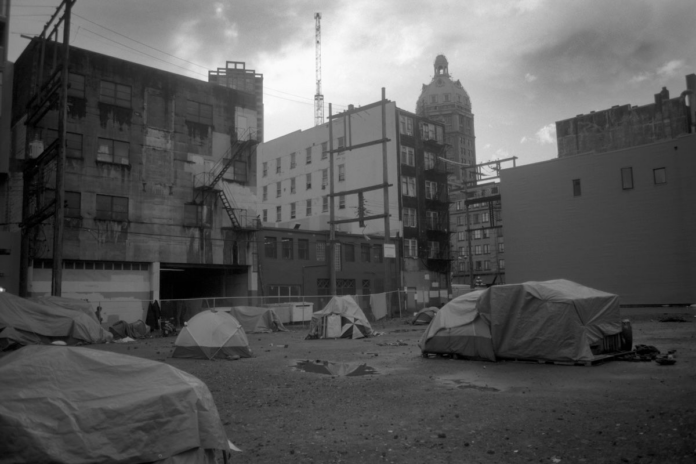The housing crisis is pushing more and more people onto the streets. More than one in 10 Canadians report experiencing some form of homelessness in their lifetime.
Forced to camp out, homeless people are increasingly victims of the not-in-my-backyard (NIMBY) phenomenon. Governments are dismantling encampments — and some are willing to use the notwithstanding clause to circumvent court rulings on their actions — as well as banning supervised drug consumption sites near day-care centres and schools.
Now involuntary treatment is seemingly on their radar.
The rise in involuntary treatments
It is currently possible to forcibly treat someone anywhere in Canada. Provincial mental health legislation allows involuntary admission and involuntary treatment.
Criteria vary from danger to a lack of capacity for consent and the need for treatment. But involuntary admission and treatment should only be used as a last resort.
The rights of citizens to decide what happens to them is fundamental. According to the Supreme Court of Canada, the right to self-determination outweighs other interests, “including what physicians may think is in the patient’s best interests.” Psychiatric diagnoses or substance addictions have no legal impact on the right to consent to care.
No data is systematically collected in Canada on the use of involuntary admission and treatment. Available studies suggest there’s been a steady increase for more than a decade in the use of mental health legislation being used to detain people in Québec, Ontario and British Columbia.
This increase is similar to the situation in other western countries, suggesting that coercion is now an integral part of mental health treatment. Racialized and Indigenous people and people living in precarious conditions are over-represented among those forced into treatment.
Research shows structural violations of the rights of people who are involuntarily admitted or treated. Class-action lawsuits have been won or are underway in several Canadian provinces for abuse of rights in psychiatric wards.
Québec will have to compensate people detained illegally.
The New Brunswick ombudsperson concluded that patients at Restigouche Hospital Centre in Campbellton were “victims of negligence, abuse and unacceptable treatment.”
British Columbia had to set up a service of rights advisers following the alarming findings of its ombudsperson in 2019. He reported a systematic failure by healthcare institutions to comply with the procedural safeguards required by the Mental Health Act, including consent to treatment, and by the Ministry of Health to adequately monitor institutions’ compliance with the procedures.
Yet the B.C. government has announced that it will expand involuntary care to keep people and communities “safe.”
Baseless arguments
The arguments made by advocates for involuntary treatments aren’t supported by science.
First, they often suggest homelessness is due to mental health issues or addiction, while research shows that financial difficulties are the primary cause of homelessness. Rising housing and living costs and low incomes are behind the unprecedented rise in homelessness.
The situation was predictable.
Economic inequality has been on the rise since the 1980s. Housing affordability has been declining over the same period. Homelessness is a structural problem, not an individual one.
Second, involuntary treatment proponents make an association between mental health/addiction and public safety, suggesting that people with mental health problems or drug users are violent.
Research has long since disproved this association in terms of mental health and the situation is nuanced for addiction. Nonetheless, involuntary treatment advocates argue that treating people against their will is necessary because they are unable to make decisions for themselves. This assumption is also disproven by research, which reveals a much more complex reality.
In addition, risk assessment and incapacity evaluation tools are controversial and primarily target marginalized and racialized people.
The focus on public safety also perpetuates prejudices and fear, which increases popular support for coercive measures like involuntary treatment. Nearly 70 per cent of Ontario residents, for example, support legislative changes to facilitate forced treatment.
Third, some politicians argue that involuntary treatment works. Current data do not support a strong causal link between involuntary treatment and treatment adherence, relapse prevention or social functioning. On the contrary, they show adverse effects associated with coercion.
Expanded access to community-based services, the use of experiential knowledge from the people concerned and a trauma-informed approach seem promising and more respectful of human rights.
Changing the language
Proponents of involuntary treatments, like Patrick Brown, the mayor of Brampton, Ont., claim “the old approach isn’t working.”
Because the term “involuntary treatment” has a negative connotation, they talk now of “compassionate care.”
This change in terminology aligns with the CARE program implemented in California in 2022. Homeless people with certain psychiatric diagnoses can be subjected to involuntary treatment through “a compassionate civil court process.” CARE’s compassionate approach is presented as a paradigm shift.
But is it?
Making it easier to confine homeless and marginalized people is, to say the least, not a new or original idea. Rather, it’s a very old approach dating back to the Middle Ages.
Involuntary treatment is claimed to be necessary because people would not enter therapy voluntarily. Yet mental health and addiction services are difficult to access across Canada thanks to decades of under-funding. It’s tough to justify violating people’s rights to engage them in involuntary treatments when voluntary treatments are inaccessible.
Compassionate care, in fact, is nothing more than a smoke screen intended to hide coercion, structural inequalities and governments’ lack of social responsibility.
Emmanuelle Bernheim, Professeure titulaire, Faculté de droit, titulaire de la Chaire de recherche du Canada en santé mentale et accès à la justice | Full Professor, Faculty of Law, Canada Research Chair on Mental Health and Access to Justice, L’Université d’Ottawa/University of Ottawa
This article is republished from The Conversation under a Creative Commons license. Read the original article.




